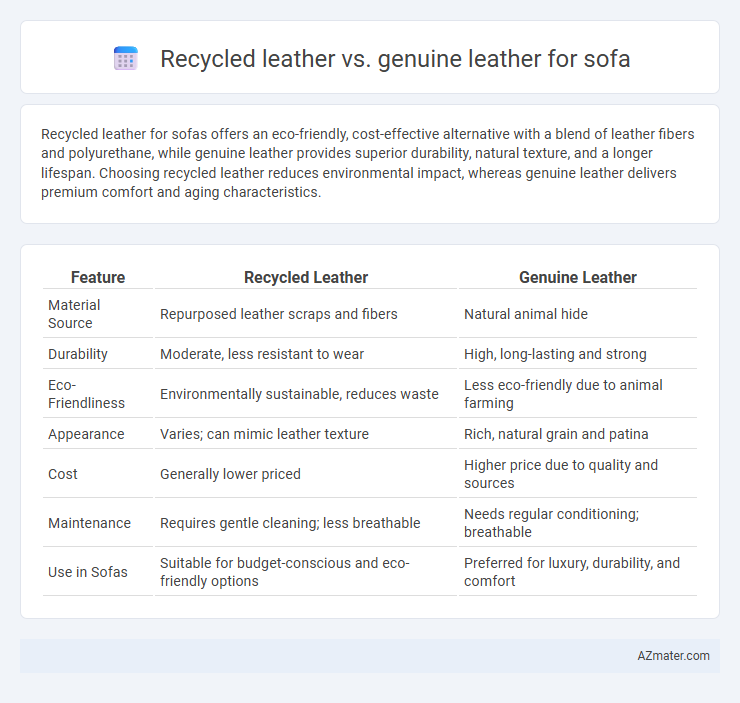Recycled leather for sofas offers an eco-friendly, cost-effective alternative with a blend of leather fibers and polyurethane, while genuine leather provides superior durability, natural texture, and a longer lifespan. Choosing recycled leather reduces environmental impact, whereas genuine leather delivers premium comfort and aging characteristics.
Table of Comparison
| Feature | Recycled Leather | Genuine Leather |
|---|---|---|
| Material Source | Repurposed leather scraps and fibers | Natural animal hide |
| Durability | Moderate, less resistant to wear | High, long-lasting and strong |
| Eco-Friendliness | Environmentally sustainable, reduces waste | Less eco-friendly due to animal farming |
| Appearance | Varies; can mimic leather texture | Rich, natural grain and patina |
| Cost | Generally lower priced | Higher price due to quality and sources |
| Maintenance | Requires gentle cleaning; less breathable | Needs regular conditioning; breathable |
| Use in Sofas | Suitable for budget-conscious and eco-friendly options | Preferred for luxury, durability, and comfort |
Introduction: Recycled Leather vs Genuine Leather Sofa
Recycled leather sofa combines genuine leather fibers with polyurethane and adhesives, offering a sustainable and cost-effective alternative to traditional genuine leather. Genuine leather sofas, crafted from animal hides, provide superior durability, natural texture, and breathability, often commanding a higher price due to the quality of materials. Choosing between recycled and genuine leather impacts furniture longevity, maintenance requirements, and environmental footprint in home decor decisions.
What is Recycled Leather?
Recycled leather is a sustainable material created by reprocessing leather scraps and fibers from manufacturing waste, bonding them with polyurethane or other binders to form sheets used in sofa upholstery. Unlike genuine leather, which is derived directly from animal hides, recycled leather offers an eco-friendly alternative by reducing waste and minimizing the environmental impact of leather production. This material provides a leather-like appearance and texture while supporting circular economy principles in furniture manufacturing.
What is Genuine Leather?
Genuine leather is made from the natural hide of animals, primarily cows, and undergoes tanning and finishing processes to enhance durability and appearance. It offers breathability, strength, and develops a unique patina over time, making it a preferred choice for high-quality sofas. Unlike synthetic options, genuine leather maintains its integrity with proper care, providing long-lasting comfort and style.
Appearance and Texture Comparison
Recycled leather often showcases a more uniform appearance with consistent color and texture, while genuine leather displays natural variations that highlight its unique grains and imperfections. The texture of recycled leather tends to feel smoother and less breathable compared to genuine leather's supple, soft, and porous surface that develops a rich patina over time. Genuine leather's authentic look and tactile depth make it highly desirable for sofas seeking a luxurious and classic aesthetic.
Durability and Longevity
Recycled leather offers a sustainable alternative to genuine leather but generally lacks the same durability and longevity, often wearing out faster due to its composite nature of leather scraps and synthetic materials. Genuine leather is known for its resilience and ability to develop a rich patina over time, making it a preferred choice for long-lasting sofas that can withstand daily use and environmental factors. Investing in genuine leather ensures extended lifespan and maintained aesthetic appeal, while recycled leather provides a budget-friendly and eco-conscious option with a shorter functional lifespan.
Environmental Impact and Sustainability
Recycled leather significantly reduces environmental pollution by repurposing leather scraps and minimizing landfill waste compared to genuine leather, which involves resource-intensive animal farming and chemical tanning processes. The production of recycled leather consumes less water and energy, lowering carbon emissions and fostering circular economy practices within the furniture industry. Genuine leather's sustainability is challenged by deforestation and heavy chemical use, whereas recycled leather supports eco-friendly manufacturing and reduced leather waste.
Cost and Affordability
Recycled leather sofas typically cost 30-50% less than genuine leather, offering a budget-friendly option without compromising on style. Genuine leather demands a higher upfront investment due to its durability and natural quality, often lasting longer and justifying the expense over time. Affordability depends on usage expectations, with recycled leather appealing to cost-conscious buyers seeking eco-friendly alternatives.
Maintenance and Care Requirements
Recycled leather sofas require less intensive maintenance than genuine leather as their protective coatings resist stains and moisture, reducing the need for frequent conditioning. Genuine leather demands regular cleaning with specialized leather cleaners and periodic application of conditioners to prevent drying and cracking, ensuring durability. Both materials benefit from avoiding prolonged sun exposure, but recycled leather's synthetic composition offers enhanced resistance to wear and simpler upkeep routines.
Comfort and Feel Experience
Recycled leather offers a softer, more pliable texture that enhances initial comfort but may lack the durability and natural breathability of genuine leather. Genuine leather provides a rich, supple feel that improves with age, molding to the body while maintaining firm support and temperature regulation. For sofas, genuine leather delivers a premium tactile experience with long-lasting comfort, whereas recycled leather suits budget-conscious consumers seeking eco-friendly alternatives with a smooth touch.
Which Leather is Best for Your Sofa?
Recycled leather offers an eco-friendly and cost-effective alternative to genuine leather, combining leather scraps with polyurethane to create a durable yet less breathable material. Genuine leather provides natural durability, breathability, and a premium feel, making it ideal for long-term use and comfort in sofas. Choosing the best leather for your sofa depends on prioritizing sustainability and budget with recycled leather or durability and luxury with genuine leather.

Infographic: Recycled leather vs Genuine leather for Sofa
 azmater.com
azmater.com